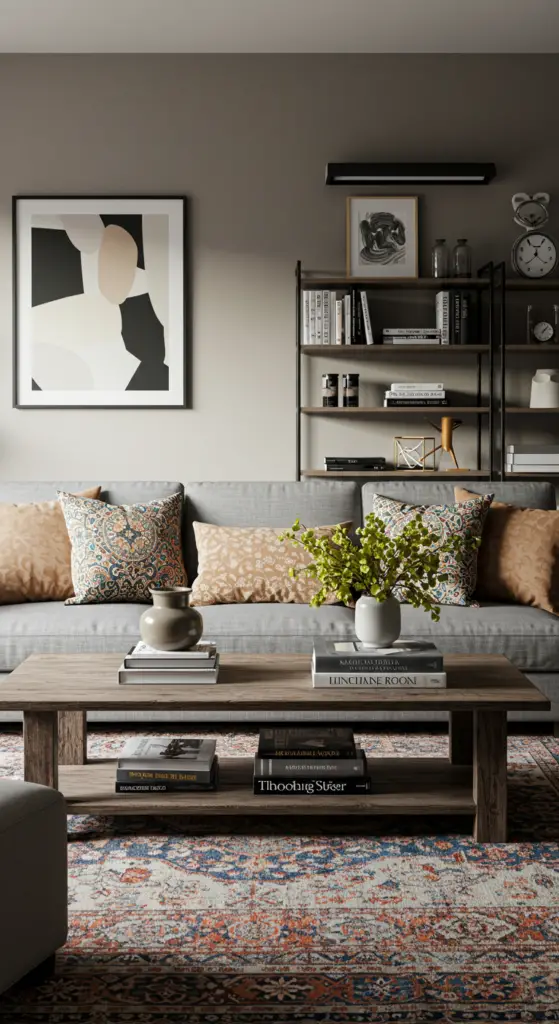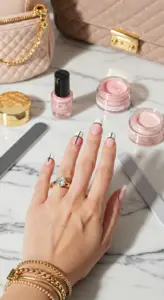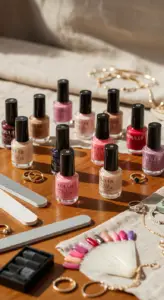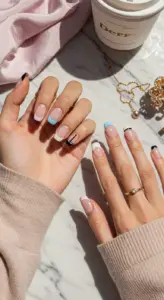1. Blend Mid-Century Modern Furniture with Classic Vintage Accents
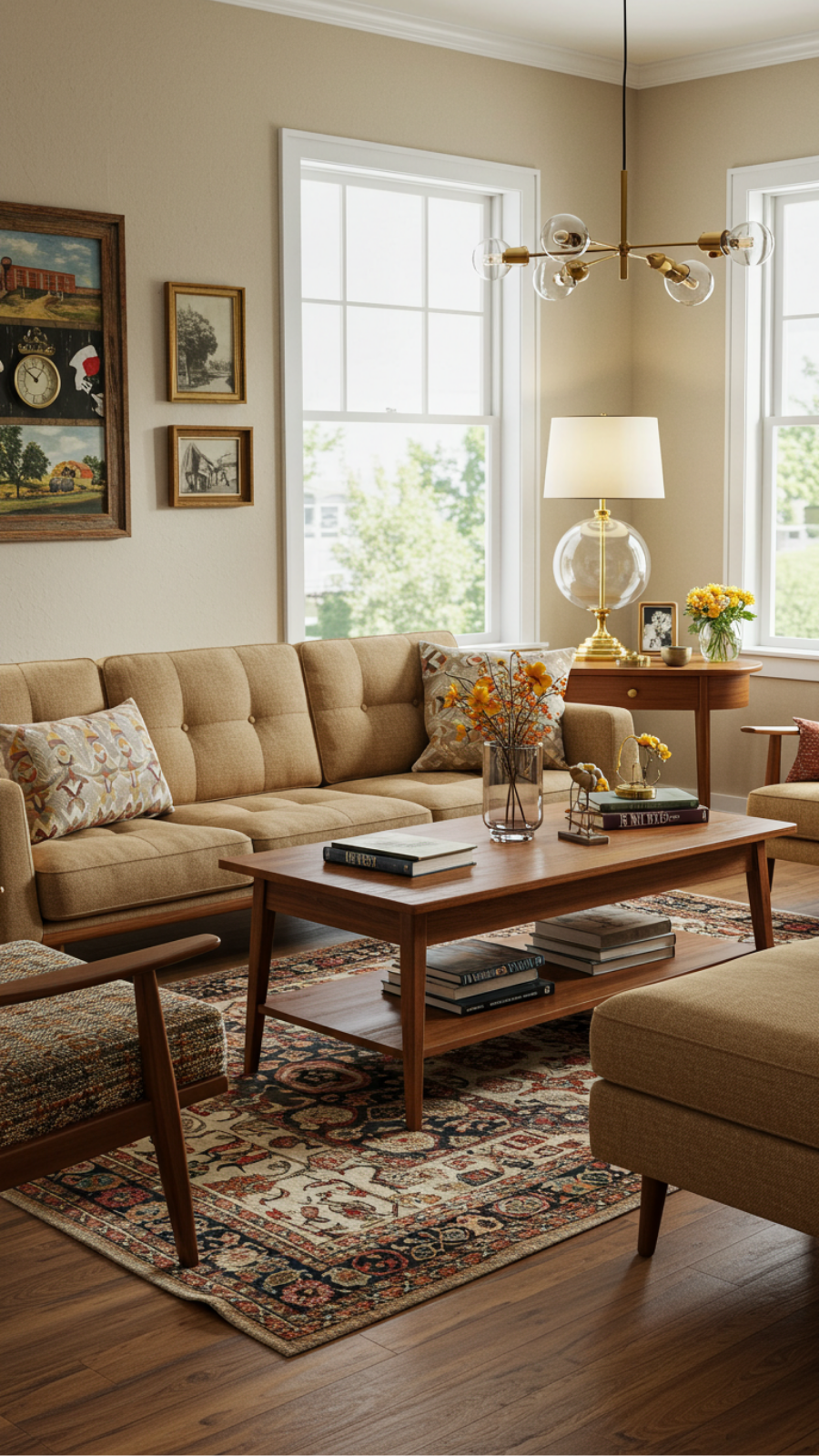
Blend Mid-Century Modern Furniture with Classic Vintage Accents
Combining Mid-Century Modern furniture with classic vintage accents can create a unique and inviting home decor style. This fusion not only pays homage to the sleek lines and functionality of the Mid-Century era but also adds warmth and character through vintage pieces. Here’s how to achieve this stylish blend seamlessly.
Step-by-Step Guidance
- Choose a Color Palette: Start by selecting a cohesive color scheme that highlights both Mid-Century hues (think mustard yellow and teal) and vintage tones (like muted pastels).
- Mix Materials: Pair iconic Mid-Century materials such as teak or walnut wood with vintage textiles like velvet or floral patterns. This contrast adds depth to your space.
- Accent with Vintage Finds: Incorporate vintage accents like an ornate mirror or a retro lamp to soften the clean lines of Mid-Century furniture.
- Layer Textures: Use various textures—such as a chunky knit throw on a sleek sofa—to create visual interest.
Expert Tips and Tricks
To master this decor style, avoid common mistakes such as overcrowding your space with too many contrasting elements. Instead, focus on a few standout pieces that complement each other. Aim for balance by ensuring that your vintage accents do not overshadow your Mid-Century furniture.
Current Trends in Home Decor
Currently, trends lean towards sustainability, making vintage finds highly desirable. Incorporating these elements not only enhances decor but also promotes eco-friendly practices.
By following these best practices, you can create a harmonious living space that showcases both Mid-Century Modern and vintage styles, resulting in a home that feels both curated and lived-in. Remember, the key is to celebrate individuality while maintaining a cohesive look!
2. Incorporate Traditional Textile Patterns into Contemporary Upholstery
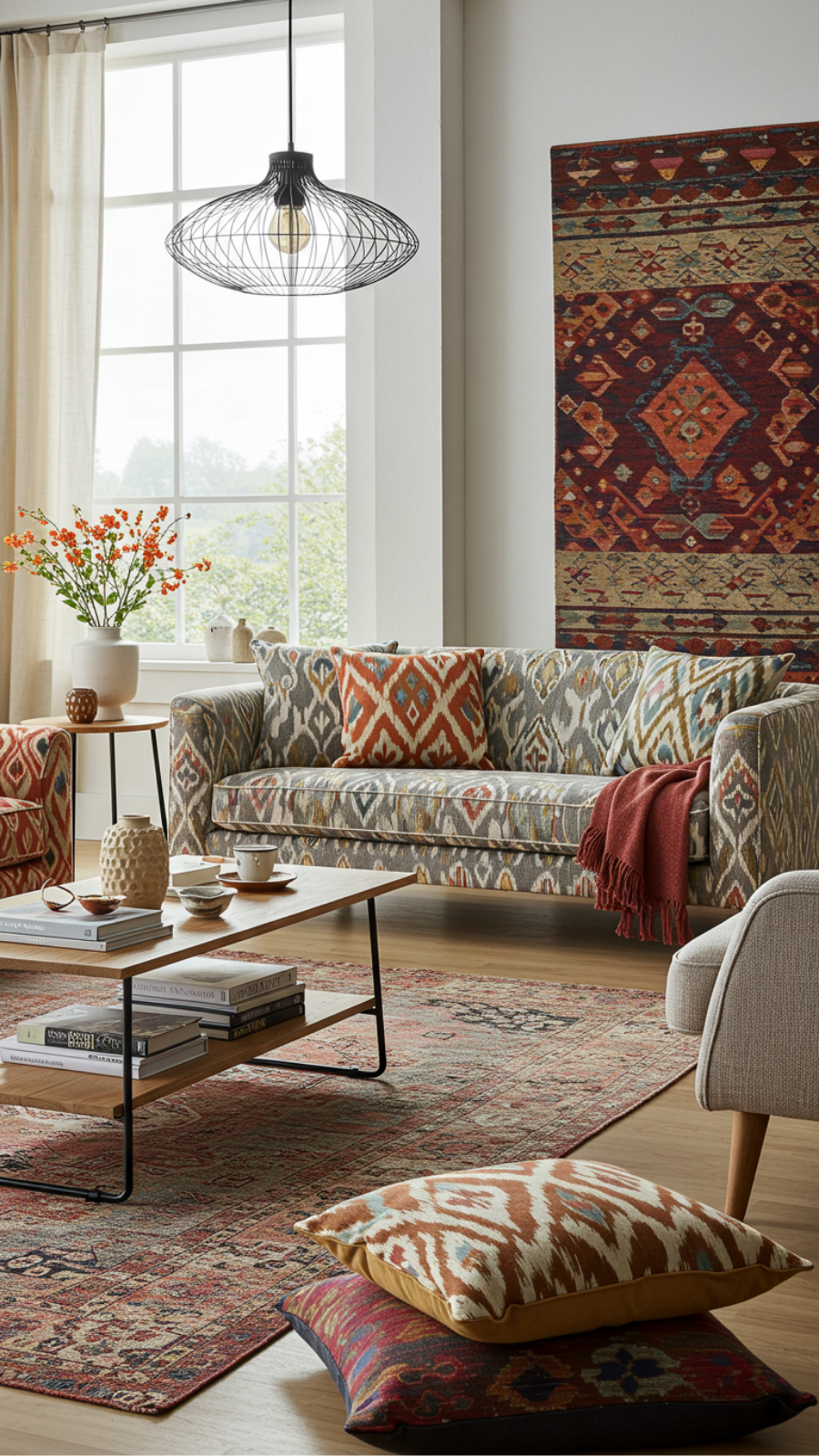
Incorporate Traditional Textile Patterns into Contemporary Upholstery
Blending traditional textile patterns with contemporary upholstery is a sophisticated way to elevate your home decor. This fusion not only adds character but also creates a unique aesthetic that resonates with current design trends. Here’s how to seamlessly integrate these elements into your living space.
Step-by-Step Guidance
- Choose Your Patterns: Start by selecting traditional textile patterns that speak to you—think ikat, paisley, or tribal motifs. These can serve as focal points in your decor.
- Select the Right Upholstery: Opt for contemporary furniture silhouettes that complement these patterns. A sleek, modern sofa can be beautifully offset by a vintage-inspired fabric.
- Balance the Aesthetic: Pair bold patterns with neutral colors to prevent visual overwhelm. For example, a vibrant ikat throw pillow can stand out against a solid gray sofa.
Expert Tips and Tricks
Consider mixing patterns thoughtfully. Use varying scales to create depth—small patterns can pair well with larger prints. Additionally, avoid common mistakes like overloading a space with too many competing visuals, which can detract from the intended elegance.
Current Trends in Home Decor
In 2023, the trend leans towards a global eclectic style, where traditional textiles are making a comeback in contemporary interiors. Incorporating these elements not only adds warmth but also tells a story, making your home truly unique.
Best Practices
When choosing fabrics, prioritize quality over quantity. Natural materials such as cotton, wool, and linen are not only durable but also enhance the vibrancy of traditional patterns. Lastly, maintain a cohesive color palette to tie your space together.
By thoughtfully incorporating traditional textile patterns into contemporary upholstery, you can create a harmonious and inviting atmosphere that reflects your personal style.
3. Mix Industrial Lighting Fixtures with Antique Wooden Furniture Pieces
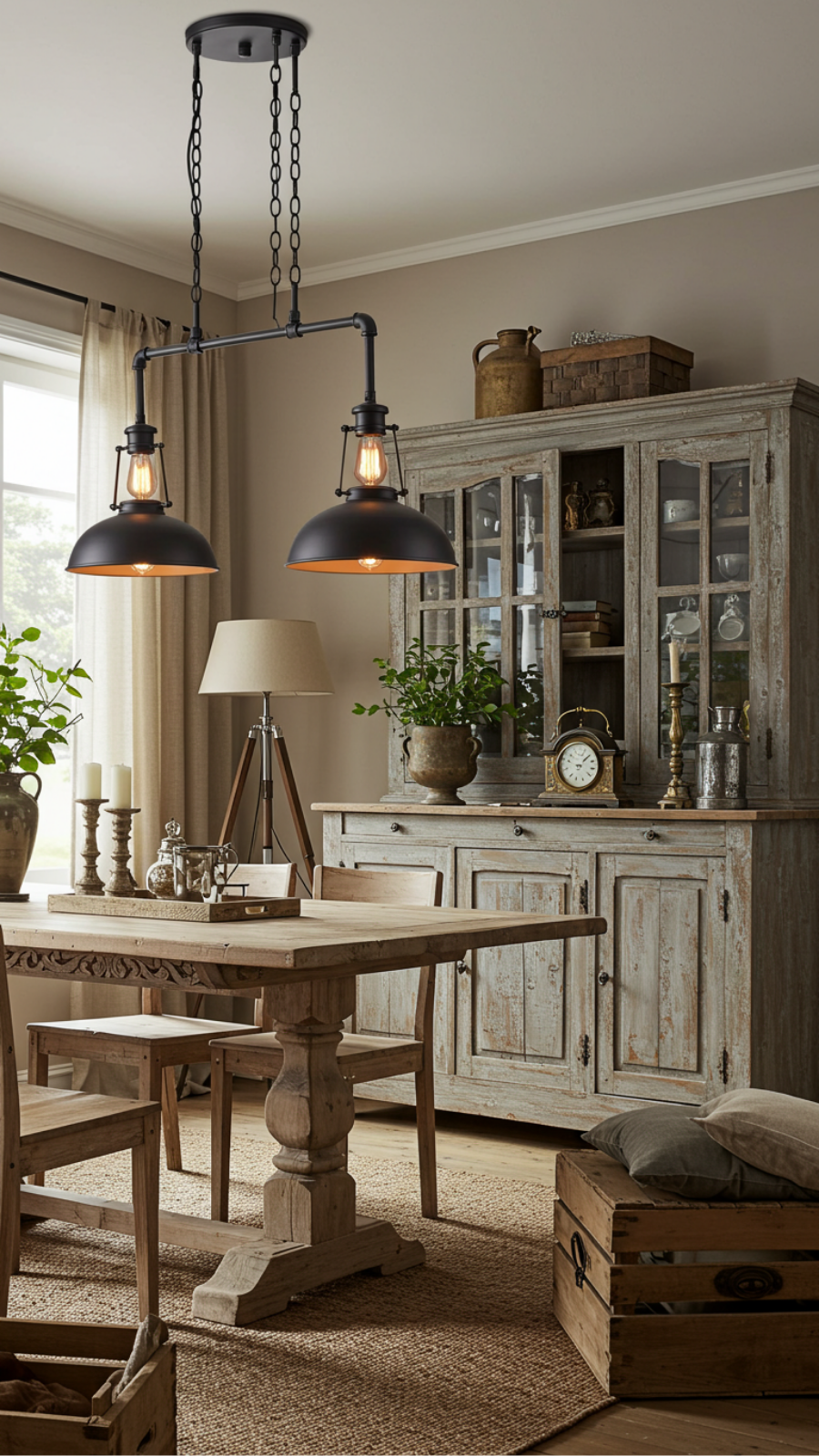
Mixing Industrial Lighting Fixtures with Antique Wooden Furniture Pieces
Combining industrial lighting fixtures with antique wooden furniture pieces creates a captivating contrast that enhances your home decor. This trend not only adds character but also infuses a unique personality into your space.
Step-by-Step Guidance
To effectively mix these styles, follow these expert tips:
- Select a Focal Point: Choose a statement industrial light fixture, such as a pendant or chandelier, to serve as the centerpiece of the room.
- Complement with Color: Opt for wooden furniture that features warm tones to balance the coolness of metal fixtures.
- Layer Textures: Incorporate various materials, like leather or fabric, to soften the overall aesthetic and create visual interest.
Common Mistakes to Avoid
While blending these styles can be rewarding, avoid these pitfalls:
- Overcrowding the space with too many items from both styles. Aim for a curated look.
- Neglecting lighting placement; ensure your industrial fixtures are strategically positioned for optimal illumination.
Best Practices for a Cohesive Look
For a harmonious decor scheme:
- Mix metals judiciously; using the same finish throughout can unify the space.
- Incorporate greenery to soften the edges of industrial elements and bring life to antique wood.
By thoughtfully combining industrial lighting fixtures with antique wooden furniture, you can create a stylish and inviting atmosphere that reflects your personal taste. Embrace this trend to transform your home into a stunning sanctuary.
4. Create Contrast Using Modern Art with Traditional Framed Portraits
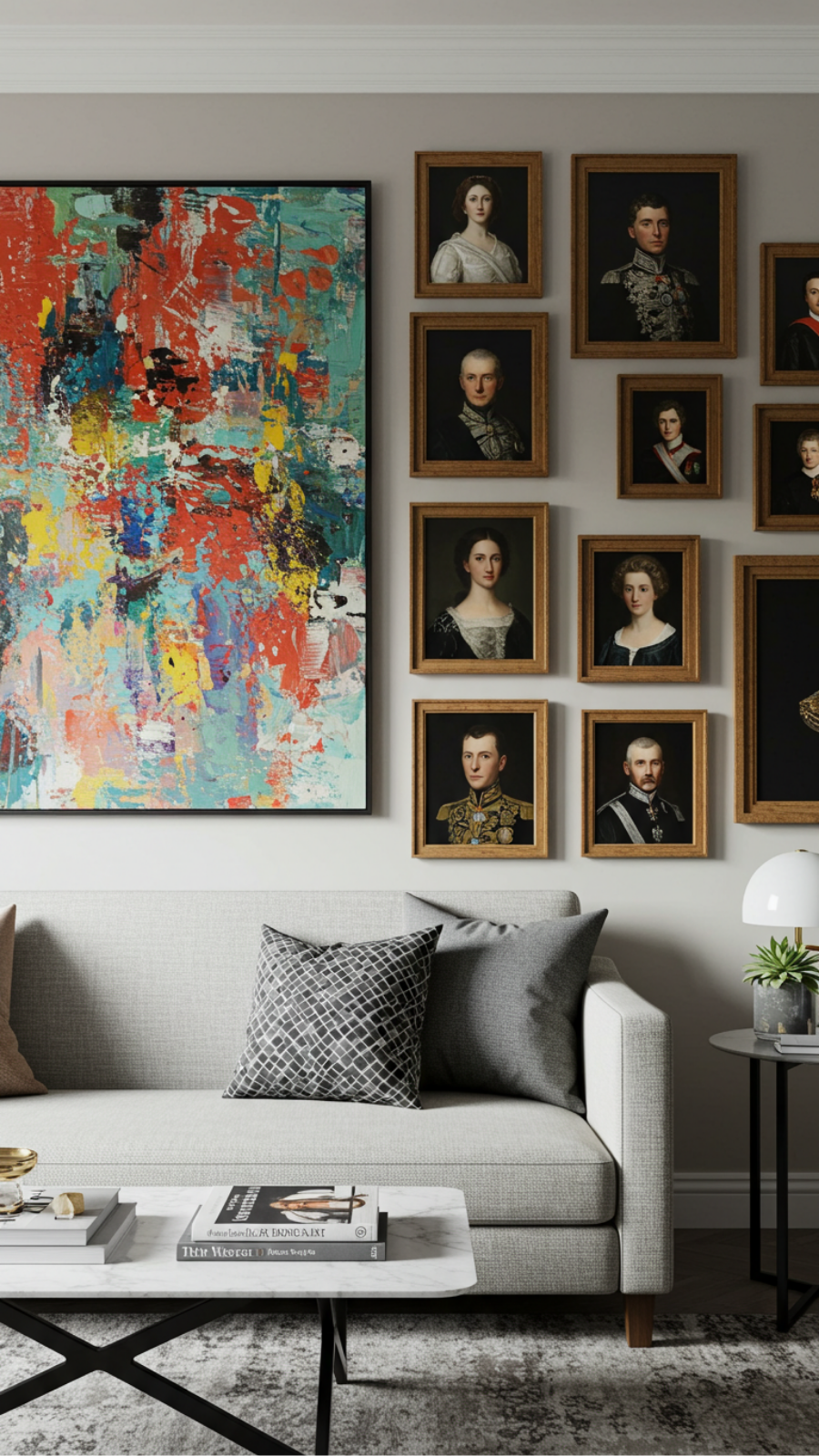
Create Contrast Using Modern Art with Traditional Framed Portraits
Combining modern art with traditional framed portraits is a powerful way to create visual contrast in your home decor. This fusion not only highlights the unique characteristics of each style but also adds depth and intrigue to your living space. Here’s how to master this trend with expert advice and practical examples.
Step-by-Step Guidance
- Select Your Artwork: Choose a bold modern piece, such as an abstract or geometric print, that resonates with your personal style.
- Frame It Right: Opt for simple, sleek frames for modern art. In contrast, use ornate, vintage-style frames for traditional portraits to enhance their classic appeal.
- Create a Gallery Wall: Arrange these pieces together to form a cohesive gallery wall. Ensure balance by interspersing different sizes and orientations.
- Consider Color Schemes: Use a color palette that ties both styles together. Neutral backgrounds can help modern art pop, while rich colors can enhance traditional portraits.
Expert Tips and Tricks
- Use lighting strategically to draw attention to both styles, highlighting their unique features.
- Incorporate a common theme or color in both art styles to create harmony.
- Avoid overcrowding your wall; leave breathing space between pieces for maximum impact.
Common Mistakes to Avoid
- Mixing too many styles can lead to visual chaos; stick to a few select pieces.
- Neglecting the scale of your art can make it difficult for your decor to feel cohesive.
By thoughtfully combining modern art with traditional framed portraits, you can create a stunning contrast that enhances your home’s aesthetic. Embrace this trend to showcase your personality while staying on the cutting edge of home decor inspirations.
5. Layer Textures: Combine Contemporary Rugs with Classic Hardwood Floors
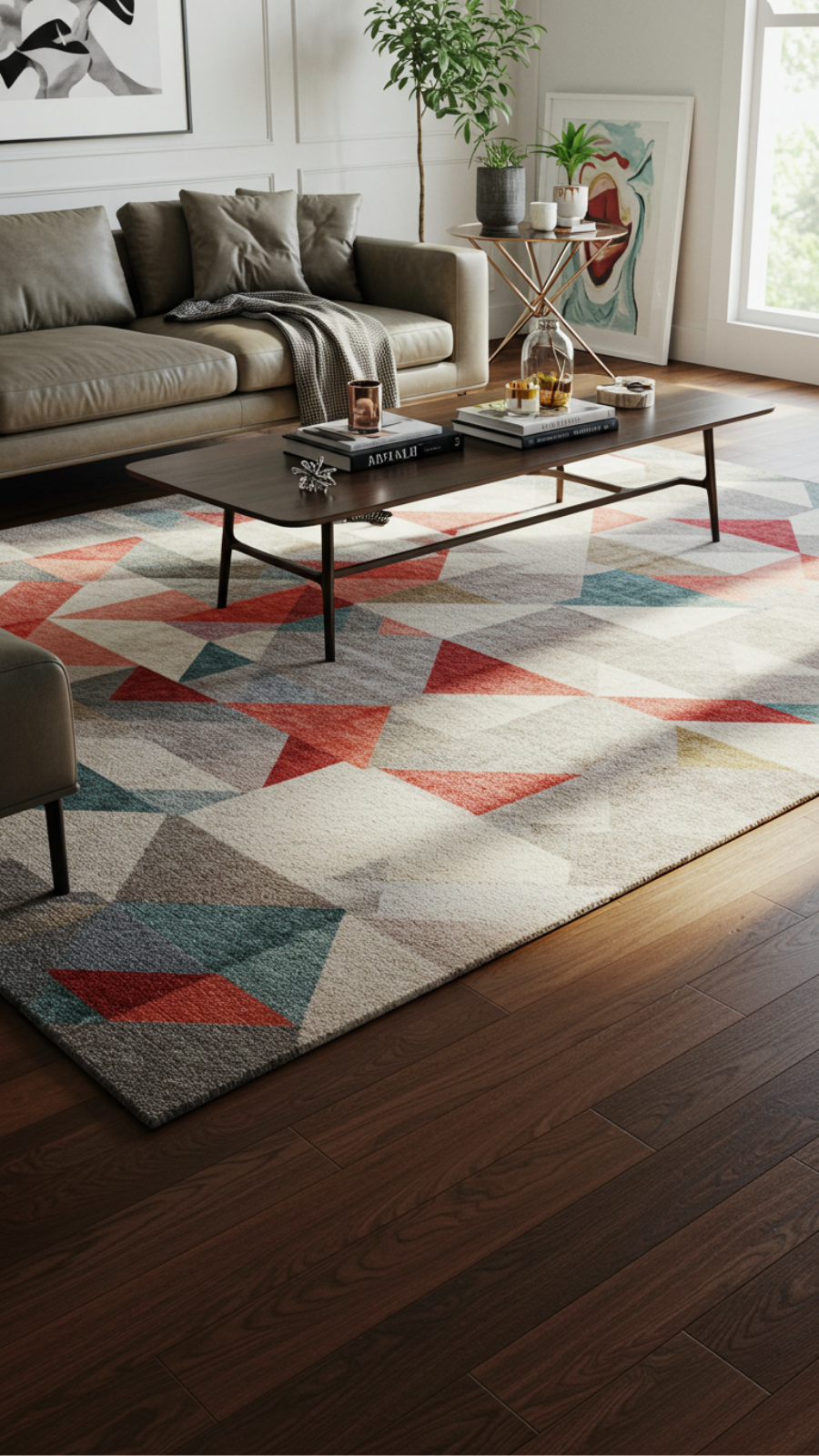
Layer Textures: Combine Contemporary Rugs with Classic Hardwood Floors
Layering textures is a key trend in home decor, and one of the most effective ways to achieve this is by combining contemporary rugs with classic hardwood floors. This dynamic juxtaposition not only adds depth and warmth to your space but also creates a visually appealing focal point.
Step-by-Step Guidance
To master this layering technique, follow these expert tips:
- Select the Right Rug: Choose a contemporary rug that complements the color and grain of your hardwood floors. Look for geometric patterns or bold colors that stand out.
- Consider Size: Ensure the rug is proportionate to the room. A larger rug can anchor furniture, while a smaller one can add a pop of style.
- Play with Textures: Mix soft, plush rugs with the natural hardness of wood. This contrast enhances the tactile experience.
- Layer with Purpose: Position the rug in a way that creates zones, such as a cozy reading nook or a defined dining area.
Common Mistakes to Avoid
When layering textures, be mindful of these pitfalls:
- Choosing rugs that are too small can make a space feel disjointed.
- Neglecting to consider the room’s overall color palette may result in clashing tones.
- Overcrowding the space with too many patterns can create visual chaos.
Best Practices for Success
Embrace these best practices to elevate your decor:
- Mix different styles, such as modern and traditional, to create an eclectic look.
- Regularly update your rugs to stay in line with current trends, ensuring your decor feels fresh.
- Incorporate accessories like cushions or throws that echo the rug’s colors to unify the look.
By skillfully layering contemporary rugs with classic hardwood floors, you can enhance your home’s aesthetic while enjoying the comfort and style this technique offers. Start experimenting today to create a living space that truly reflects your personal style.
6. Utilize Neutral Color Palettes to Harmonize Styles in Living Spaces
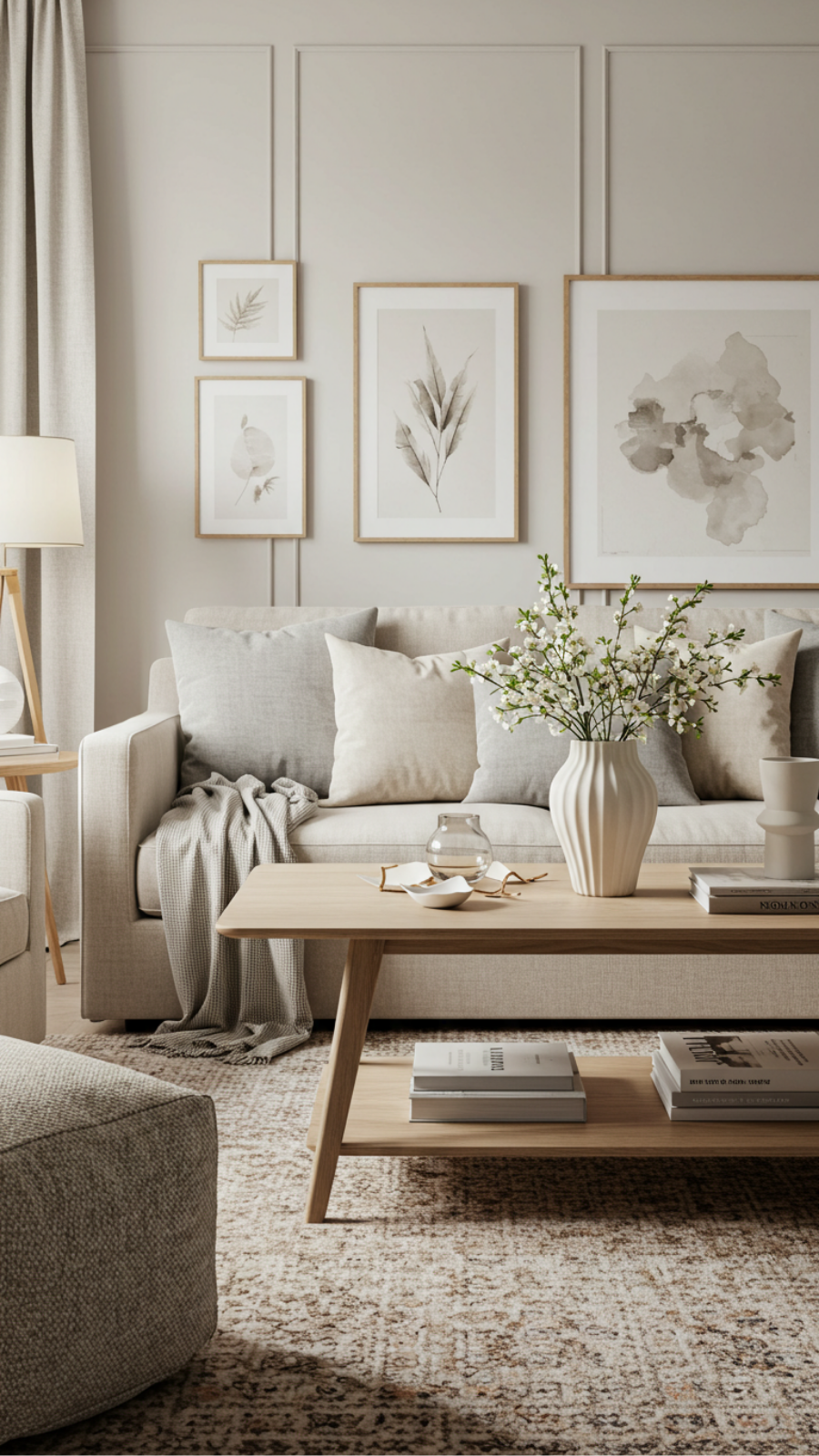
Utilize Neutral Color Palettes to Harmonize Styles in Living Spaces
Embracing neutral color palettes is a timeless strategy in home decor that promotes harmony across different styles in living spaces. Neutral tones, such as beiges, grays, and soft whites, serve as a versatile backdrop, allowing various design elements to shine without clashing.
Current Trends in Neutral Decor
As 2023 unfolds, the trend of incorporating earthy and muted neutrals is gaining traction. Think warm taupes paired with crisp whites or soft pastels to create a serene ambiance. This approach not only aligns with the natural decor movement but also evokes a sense of tranquility.
Step-by-Step Guidance
- Select Your Base Color: Start with a neutral base, such as a light gray or beige.
- Layer Textures: Use textiles like woven rugs, linen curtains, and plush cushions to add depth.
- Incorporate Accents: Introduce pops of color through artwork or decorative pillows to maintain interest.
- Balance Styles: Mix contemporary and traditional pieces by ensuring your neutral palette ties them together.
Expert Tips and Common Mistakes
One common mistake is neglecting the importance of lighting. Natural and artificial light can drastically change how neutrals appear, so test paint samples in different lighting conditions. Additionally, avoid overloading the space with too many contrasting colors; instead, stick to a cohesive palette.
Best Practices
- Choose a focal point, like a statement piece of furniture, to anchor your decor.
- Use varying shades within your neutral palette to add dimension.
- Incorporate greenery to breathe life into your space while maintaining a neutral theme.
By utilizing neutral color palettes effectively, you can create harmonious living spaces that reflect your personal style while staying on-trend.
7. Accessorize with Modern Sculptures alongside Traditional Ceramics
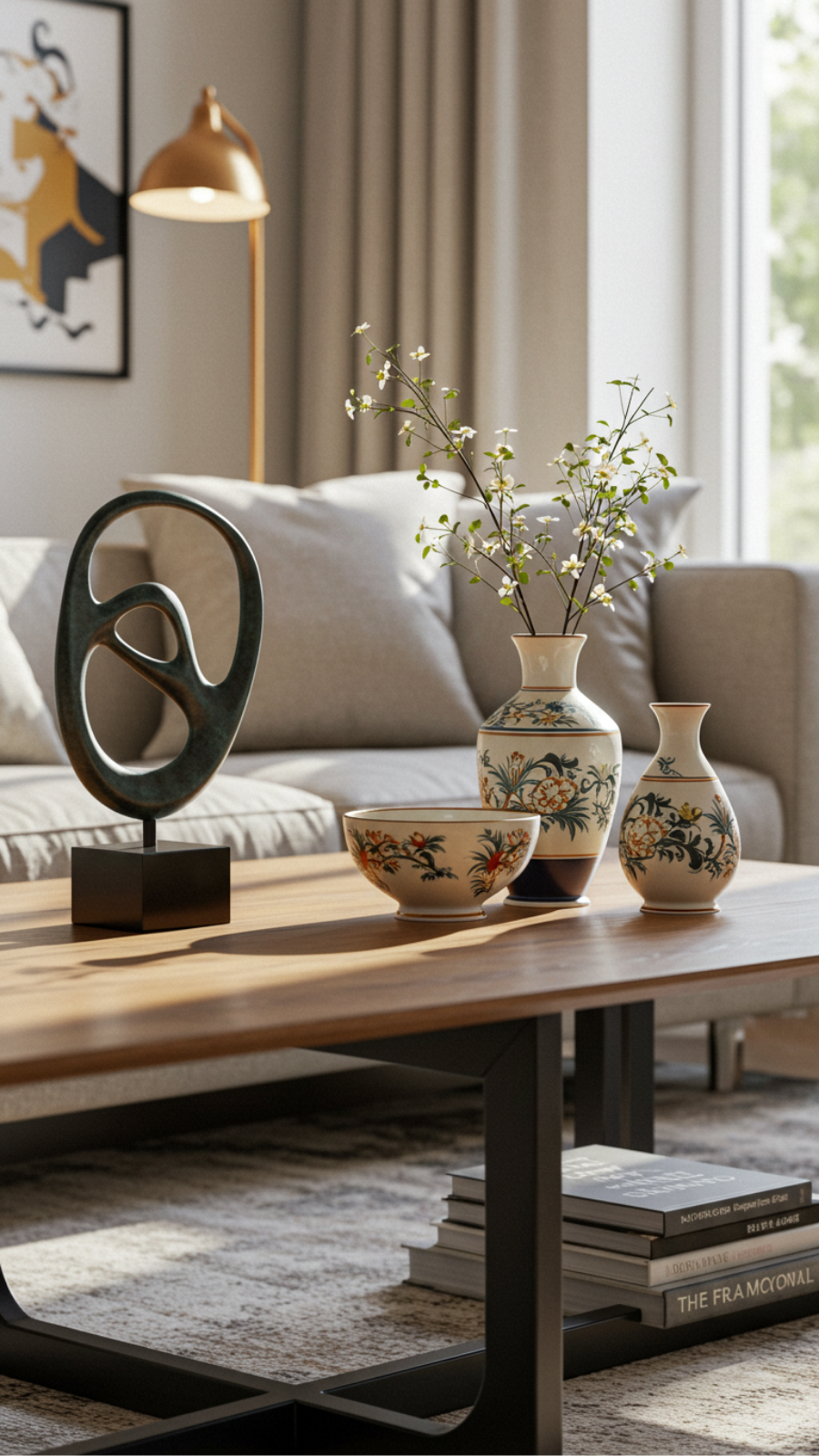
Accessorize with Modern Sculptures alongside Traditional Ceramics
In the ever-evolving world of home decor, blending modern sculptures with traditional ceramics is a powerful way to create a visually striking and harmonious aesthetic. This combination not only showcases artistic diversity but also reflects a unique narrative in your living space.
Current Trends in Home Decor
As of 2023, there’s a notable trend towards eclectic decor styles that emphasize personal expression. Using modern sculptures can add a contemporary edge to the classic charm of traditional ceramics, creating an inviting atmosphere that resonates with both sophistication and warmth.
Expert Tips for Accessorizing
- Choose a Focal Point: Start by selecting a standout modern sculpture that draws the eye. Position it prominently on a console table or mantelpiece.
- Layering Techniques: Use traditional ceramics, such as vases or bowls, to complement your sculpture. Place them at varying heights to create visual interest.
- Color Coordination: Opt for a cohesive color palette. Neutral sculptures can enhance colorful ceramics, while bold sculptures can energize muted tones.
Common Mistakes to Avoid
When integrating modern sculptures with traditional ceramics, be wary of overcrowding your space. Each piece should have room to breathe. Additionally, mismatched styles can clash; ensure that your selections harmonize rather than compete.
Best Practices for a Cohesive Look
To achieve a balanced decor, consider these best practices:
- Mix textures—pair glossy sculptures with matte ceramics.
- Utilize negative space to enhance visibility.
- Incorporate lighting to highlight both mediums effectively.
By thoughtfully accessorizing with modern sculptures alongside traditional ceramics, you can create a dynamic and inviting space that reflects your personal style while staying on-trend. Embrace this fusion to elevate your home decor to new heights!
8. Showcase a Gallery Wall Merging Modern Prints and Classic Artworks

Showcase a Gallery Wall Merging Modern Prints and Classic Artworks
Creating a stunning gallery wall that beautifully merges modern prints with classic artworks is a fantastic way to elevate your home decor. This design trend not only showcases your personality but also adds depth and character to your space. Here’s how to achieve a cohesive and striking gallery wall.
Step-by-Step Guidance
- Choose a Focal Point: Start by selecting a prominent piece, such as a large classic painting or a modern abstract print, that will serve as the centerpiece of your gallery wall.
- Mix and Match: Combine different styles and sizes of frames. Use sleek, minimalist frames for modern prints and ornate, vintage frames for classic artworks to create visual interest.
- Establish a Color Palette: Ensure the colors of the prints and artworks complement each other. A common palette unifies the gallery wall while allowing for individual pieces to stand out.
- Plan Your Layout: Before hanging, lay out the artwork on the floor to experiment with different arrangements. Consider a grid layout for a modern touch or an eclectic salon style for a more relaxed vibe.
- Hang with Precision: Use a level and measuring tape to ensure even spacing. A common mistake is to hang pieces too high or unevenly.
Expert Tips and Common Mistakes to Avoid
To make the most of your gallery wall:
- Incorporate wall decor elements like shelves or decorative objects to break the monotony.
- Avoid overcrowding; leave some space between pieces to allow each artwork to breathe.
By following these best practices, you can successfully showcase a gallery wall that merges modern prints and classic artworks, making a striking statement in your home.
Frequently Asked Questions
How can I blend mid-century modern furniture with classic vintage accents?
To successfully blend mid-century modern furniture with classic vintage accents, start by choosing a neutral color palette as a base. Incorporate iconic mid-century pieces, like a sleek sofa, and pair them with vintage accessories, such as an ornate mirror or antique side tables. This creates a cohesive look that highlights each style’s unique characteristics while maintaining balance.
Why should I incorporate traditional textile patterns into contemporary upholstery?
Incorporating traditional textile patterns into contemporary upholstery enriches your space by adding depth and character. It creates a visual conversation between old and new, allowing you to celebrate heritage while embracing modern design. Look for upholstery with subtle patterns, like damask or paisley, to enhance your contemporary furniture without overwhelming the overall aesthetic.
What are some effective ways to mix industrial lighting fixtures with antique wooden furniture?
To effectively mix industrial lighting fixtures with antique wooden furniture, focus on contrasting materials. Use a bold metal pendant light or a vintage-inspired industrial floor lamp to add a modern edge to the warmth of antique wood. Ensure that the finishes complement each other, for example, pairing a brushed brass fixture with a dark walnut table for a harmonious look.
How do I create contrast using modern art with traditional framed portraits?
To create striking contrast with modern art and traditional framed portraits, hang contemporary pieces alongside classic artworks in a gallery wall format. Choose frames that have a similar color or style to maintain unity, but let the art styles speak for themselves. This juxtaposition can add dynamic energy to your decor while honoring both artistic traditions.
What should I consider when layering textures, like contemporary rugs with classic hardwood floors?
When layering textures such as contemporary rugs over classic hardwood floors, consider the color and pattern of the rug in relation to the wood’s tone. Opt for a rug that contrasts the floor to create visual interest, yet complements the overall color scheme. Additionally, ensure that the rug’s material adds warmth and comfort, enhancing the inviting feel of your space.

